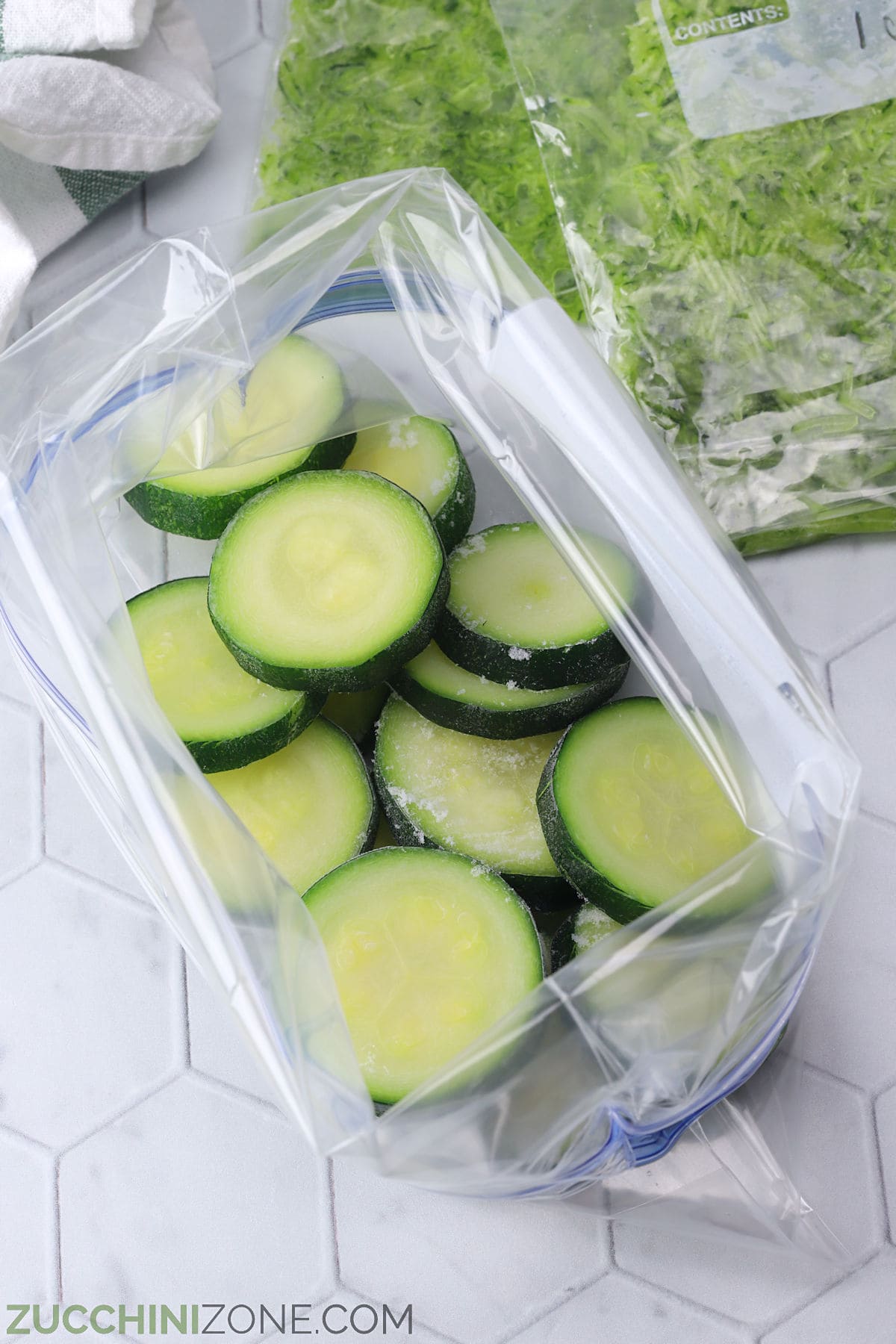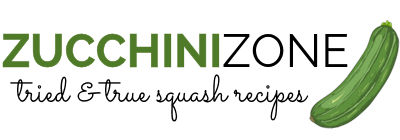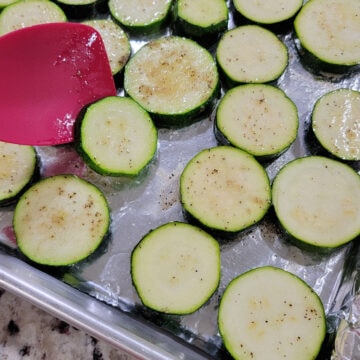Don't let that garden zucchini go to waste! Today we're talking about how to freeze zucchini (sliced and shredded) so you can enjoy that summer harvest year round.

First, you made zucchini bread. Then, zucchini boats for dinner and zucchini brownies for dessert. Tired of looking for ways to use up that fresh summer produce before it goes bad? Today I'll show you how to freeze zucchini to enjoy all year long.
Zucchini is a versatile vegetable. Its mild flavor, fiber, and nutrients blend seamlessly into baked goods and savory dishes alike. Not to mention zucchini is very easy to grow, making it a popular choice for home gardens. Before you know it, you have too much zucchini on hand and not enough time to cook it all.
Freezing zucchini is a great way to preserve that summer produce. Shredded zucchini, sliced zucchini, and cubed zucchini can all be frozen and enjoyed in recipes like stews, soups, casseroles, and breads.
Blanching
First things first - do you need to blanch zucchini before freezing? I've seen conflicting information about blanching. Some say it's a must, while others say it's unnecessary.
Blanching can improve the quality of vegetables slightly by preserving their color and flavor, as well as removing bacteria that can speed up spoiling.
However, zucchini is made up of about 95% water, making it a high water content vegetable. Produce with a high water content generally does not freeze and thaw well - it becomes mushy, soggy, and releases water. While still edible, the texture can be less than desirable.
I tested both methods by freezing a batch of raw zucchini and freezing a batch of blanched zucchini. I found no noticeable difference in texture or flavor - both were a little mushy and watery when thawed (as expected). So for me, blanching was unnecessary.
However, if you feel more comfortable blanching your veggies and want them to last as long as possible, feel free to do so. I offer detailed (optional) directions for blanching in the recipe card below.

Freezing zucchini slices
Frozen zucchini slices are great added to soups, stews, and smoothies, and don't need to be thawed beforehand.
- Whether or not you've blanched your zucchini, you'll want to pat your slices (or cubes) dry with a paper towel or tea towel.
- Choose a sheet pan that will fit flat in your freezer and line it with parchment paper.
- Spread your zucchini slices into a single layer. Make sure your zucchini slices aren't touching, otherwise they'll freeze together and form a big zucchini ice cube. Individual slices take about 1-2 hours to freeze.
- Once your slices are frozen solid, they can be transferred to an airtight, freezer-safe bag or container.
- Remove excess air before freezing to help prevent freezer burn.
Freezing shredded zucchini
Freezing shredded zucchini is a great way to prepare for future zucchini bread recipes.
- First, shred your zucchini using a box grater or food processor. See my post on how to shred zucchini for more information.
- You don't need to squeeze extra liquid out, but discard excess liquid your shredded zucchini may be sitting in.
- Portion your shredded zucchini into 1 or 1.5 cup measurements (consult your favorite bread recipes to determine how much you'll need).
- Use airtight, freezer-safe bags or freezer safe containers.
- Remove excess air before freezing to help prevent freezer burn.

Thawing
In many cases, there's no need to thaw your frozen zucchini. Slices and cubes can be tossed directly into smoothies, soups, and stews without the need to thaw first.
Shredded zucchini will need to be thawed for recipes like zucchini bread.
To thaw frozen zucchini, transfer to the refrigerator to thaw overnight. Or, place your bag of sealed, frozen zucchini (still in the bag) in a bowl of warm water to thaw quickly.
Best uses for frozen zucchini
Zucchini is made of 95% water, making it a high water content vegetable. Freezing and thawing high water content produce generally results in a mushy, watery texture. Blanched or not, your zucchini will thaw a little softer and more watery than fresh zucchini.
I do not recommend roasting frozen zucchini slices - they'll turn out watery and soft.
Frozen zucchini is best used in soups, stews, smoothies, and breads, where the texture of the zucchini isn't the star of the show. Here are a few recipes to give you an idea:
Slices and cubes:
- Blueberry zucchini smoothie
- Chocolate zucchini smoothie
- Broccoli cheddar zucchini soup
- Slow sooker turkey vegetable chili
- Potato zucchini soup
Shredded zucchini:
- Chocolate chip banana zucchini bread
- Cornbread zucchini casserole
- Applesauce zucchini bread
- Zucchini potato pancakes
- Zucchini breakfast pancakes

Frequently asked questions
- Do I need to peel my zucchini before freezing? No, there's no need to peel your zucchini. The skin of zucchini is perfectly edible and contains a high concentration of fiber and nutrients you'd be missing out on by peeling it off.
- Do I need to blanch my zucchini? In short - no. You don't need to blanch your zucchini for freezing. See the section above titled 'blanching' for more details.
- Do I need to thaw frozen zucchini before cooking? This depends on the recipe you're following. Yes, you'll need to thaw shredded zucchini before adding it to your zucchini bread batter. No, you generally don't need to thaw slices or cubes before adding frozen zucchini to soups and stews.
- How do I prevent zucchini from getting watery? Zucchini is made of 95% water, making it a high water content vegetable. Zucchini will release some water after thawing, which is why it's best used for recipes like soups, smoothies, and breads.
- How long does zucchini last in the freezer? Frozen zucchini will last for at least 3 months in a tightly sealed container, maybe longer if it's very well sealed.
📖 Recipe
How to Freeze Zucchini
Ingredients
- 2 medium zucchini, or more
- freezer-safe bags
Instructions
Sliced or cubed zucchini
- Slice zucchini into thick, ½ inch slices or cubes.
- Optionally: Bring a large pot of water to a boil. Add zucchini slices (or cubes) and blanch for 1 minute. Remove with a slotted spoon and transfer to an ice bath (water and ice in a large bowl) and allow to cool completely.
- Whether blanched or not, pat zucchini slices dry on all sides.
- Line a sheet pan with parchment paper. Arrange zucchini slices in a single layer and freeze for about 1-2 hours, or until frozen solid.
- Transfer frozen zucchini slices to an airtight, freezer-safe bag, remove excess air to prevent freezer burn, and store in the freezer for 3 months or more.
Shredded zucchini
- Using a box grater or food processor with grating blade, shred zucchini. Discard any excess, pooling liquid and transfer zucchini into airtight, freezer-safe bags or containers. Remove excess air to prevent freezer burn. Freeze for 3 months or more.
- To thaw, transfer to the refrigerator to thaw overnight. Or, place sealed plastic bag in a bowl of warm water to thaw quickly.
Recommended Equipment
Notes
- Blanching can help prolong the color and flavor of your frozen zucchini slightly, but is optional. I tested both methods and did not notice a difference between blanched and raw zucchini after thawing.
- Zucchini, blanched or not, will be slightly watery and softer than fresh zucchini. Zucchini is made of 95% water, making it a high water content vegetable. This means that it will get soft and a little 'mushy' after freezing and thawing.
- Frozen zucchini is best for recipes like soups, stews, smoothies, and breads where a firm texture is not important.










Comments
No Comments